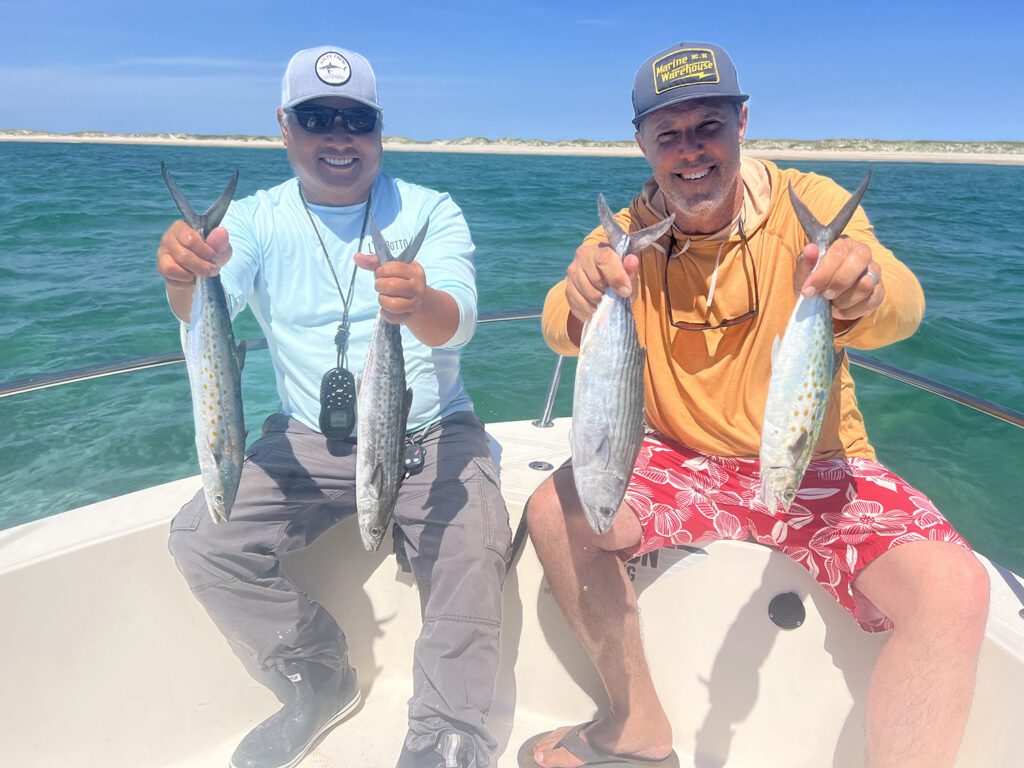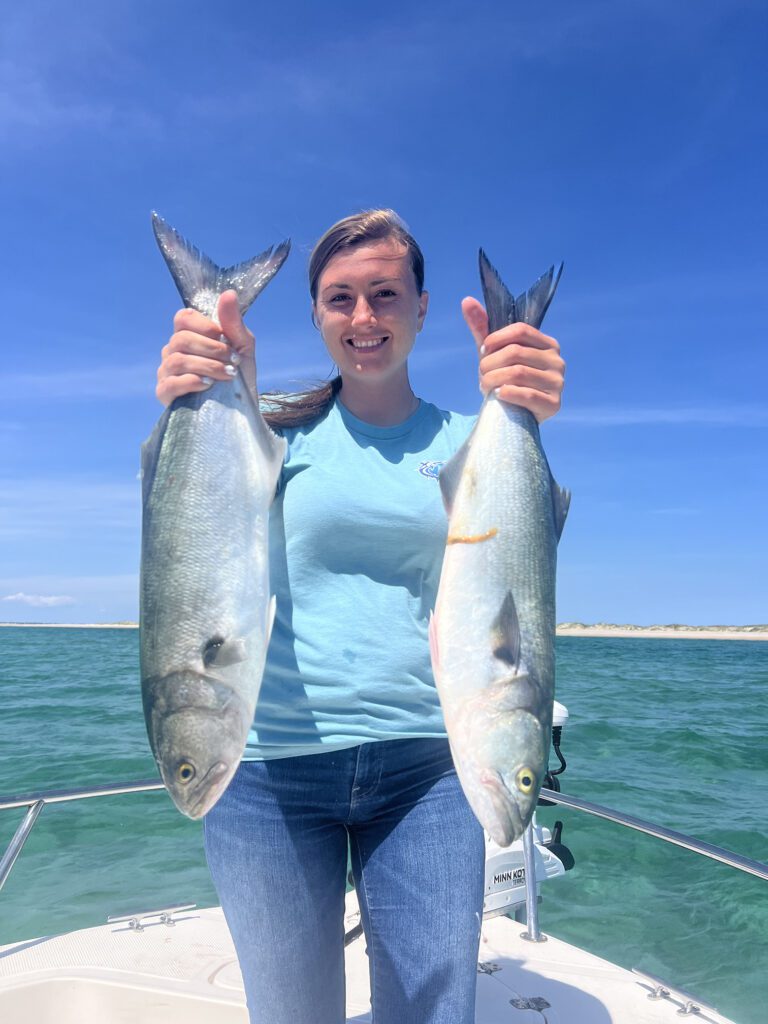Tidelines – June 2024
“The style of Top Gun Fishing,” Capt. Lee Winkleman described to me as we idled through the No Wake zone near the Morehead City port on our way back to the public boat ramp off Arendell Street, “is to give families an idea of the different styles and different variations of fishing methods. We troll, cast, live bait, jig, and bottom fish, a little bit of everything throughout a day of fishing.”
And on our half day of fishing together, Lee had checked all of the boxes.
Our first stop that morning had been just minutes from the ramp, as Lee, joined by Capt. Meagan Hopkins who has been working as Lee’s mate for the past three years, likes to try the Atlantic Beach Bridge on most trips to see if any red drum are holding next to the pilings, while someone else is casting metal out into the channel to try and hook some of the larger bluefish that have been schooling.
My role was the redfish, and Meagan’s was the blues. I pitched a Carolina rig baited with shrimp into an eddie formed behind a concrete base, easy to do with the tide nearly dead low, and Meagan tossed a Blue Water Candy Thingama Jig out into the center of the channel, let it sink to the bottom, and then jigged the lure off the bottom with a slow retrieve.
Maybe I have a knack for small sea bass, or maybe the redfish didn’t like the lull in the tide, but Meagan quickly proved she was better at bluefish than I was at redfish.
“I typically meet clients at the Arendell boat ramp,” Lee told me as he handed me a rod with another Thingama Jig tied on, “and then 10 minutes later, they’re catching hard fighting, drag pulling, acrobatic blues.”

Capt. Lee Winkleman, owner of Top Gun Fishing, and Gary Hurley, of Fisherman’s Post, with some of the spanish and bonito they caught trolling Clarkspoons near AR-315.
Many of our 22-24”, 3-4 lb. blues did put on a visual show, skying and splashing to try and shake the hook, but our itinerary was full, so we left them biting and headed to grab some live bait for our trip out to nearshore waters.
A channel marker was our next stop, and Meagan tied on a sabiki rig and steadily reeled up green shad one, two, and three at a time. Lee manned the dehooker and shuttled a dozen or so baits into the livewell. We also filled the livewell with a load of live pogies, and then headed out Beaufort Inlet and turned right.
Once over the slightly shallower water and officially on the beachfront, it was time to check trolling off the list. Lee put out a silver Clarkspoon behind a #1 planer, and the other line had a Clarkspoon behind a trolling sinker staged further back than our planer line.
“You mentioned a possible fish fry at the Hurley house sometime over the Memorial Day weekend, and spanish trolling is an easy way to get fish in the cooler, as well as search the beachfront for schools of pogies that might be holding a cobia,” explained Lee as he kept watch for bait, birds, turtles, rays, and fish, while Meagan and I watched the two rods for signs of a fish on the line.
We picked up spanish on our way towards Oceanana Pier, but we saw neither bait balls nor cobia, so Lee turned the boat left to head out to AR-315. Surprisingly, only a handful of boats were already at this very popular AR off the Atlantic Beach coast, so we made a few laps with our Clarkspoons before deciding where to post up.
AR-315, Lee told me, is an artificial reef about five miles square, with something like 50 different spots of all types of structure and debris, but today he wanted to focus on the Liberty Ship, a 130’ sunken ship.
The bonito bite in the Atlantic Beach area had been a strong one so far this year, but by our late May date, the fish had been getting smarter, smaller, and less prevalent. Still, among a couple more spanish that hit us on the troll, two late-season bonito also fell for the Clarkspoons, putting up a more noticeable fight.
Lee anchored us up on a trout and flounder hole he had marked on his machine, and by anchored up I mean spot locked us. I dropped a live pogie to the bottom, Lee freelined a green shad off the back and sat another live pogie on the bottom, and Meagan started live chumming, throwing out bait nets of live and mostly live pogies, to see if any bonito could be goaded into a feeding frenzy.
For me, the flounder and trout hole was just a flounder hole, as I only pulled up flatfish, and while Meagan did create a short and quick bonito surface attack with the scattered pogies, the feeding was out of reach and over too quickly for our casting metals to be effective.

Capt. Meagan Hopkins, of Top Gun Fishing, with two of the bluefish caught by casting metals under the Atlantic Beach Bridge.
I’m not sure what the rule is called, but if you have a couple of live bait rods out, it’s going to be the lightest rod that gets the biggest bite, and that’s what happened to us when the ultralight trout rod with a 3000 reel spooled with 15 lb. braid doubled over as something heavy took the live pogie.
I kept as much pressure as possible, given the gear, and the fight lasted about 10 minutes before we broke off the mystery fish. Part of me wants to think I was hooked to a cobia, and part of me prefers to think it was a shark.
Even though we had already checked off bottom fishing, casting, trolling, jigging, and live baiting, Lee couldn’t help but stop near the Coast Guard Station on the way in, and we picked up some small specks and a pan-sized sea mullet by casting soft plastics.
So if that’s the kind of trip you want to go on, a trip where captain and crew are motivated to find fish, put fish in the cooler, and give you experiences with a multitude of fishing techniques until you find the one that most excites you, then give Capt. Lee Winkleman, of Top Gun Fishing out of Morehead City, a call at (757) 761-2167, or visit him online at www.topgunfishing.com.
Depending on your interests, he can take you on the 23’ Key West or the 29’ Cape Horn, and you, too, can check all the boxes while figuring out what type of angler you prefer to be.
